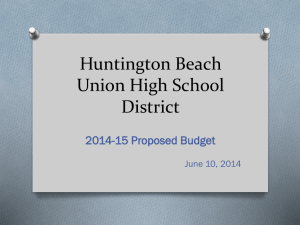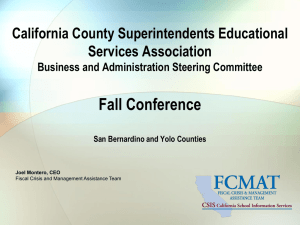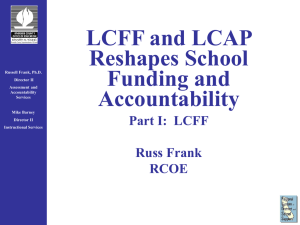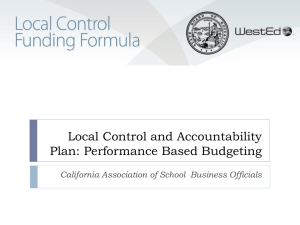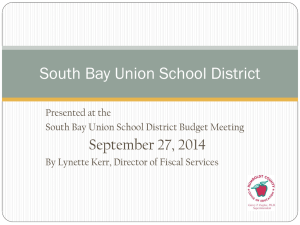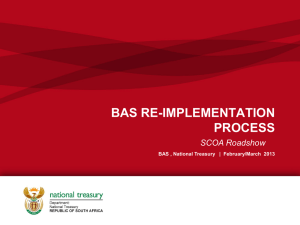Detailed Review of the LCFF Calculation -
advertisement
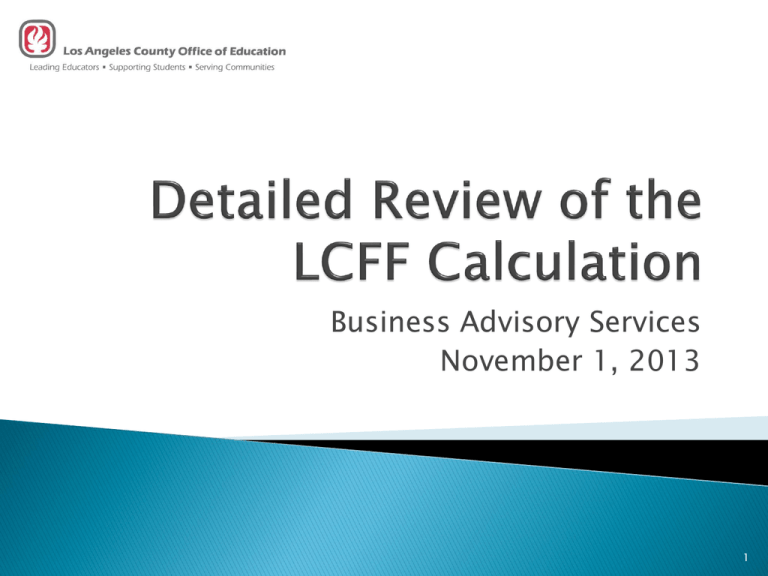
Business Advisory Services November 1, 2013 1 Overview BAS Revenue Projection System LCFF Calculations 2 3 Understand the BAS Revenue Projection System Understand the LCFF Calculations 4 FCMAT Calculator ◦ Formerly the BASC Calculator Developed by COEs statewide ◦ Available at: http://www.fcmat.org/stories/storyReader$23157 ◦ For both districts and charter schools ◦ Allows close examination of calculation and data ◦ Requires substantial data input ◦ Factors (COLA, Gap funding) and core calculations sync with BAS Revenue Projections SSC Estimator ◦ Uses different factors ◦ Provides only results – we can’t help reconcile 5 BAS Revenue Projection System ◦ Available for Los Angeles County school districts Charter school module not available at this time ◦ Less data input by districts BAS inputs much of the data ◦ ◦ ◦ ◦ ◦ Part of a larger integrated system Uses same factors and core calculations as the FCMAT Calculator – materially the same results Allow close examination of calculation and data BAS uses to validate districts’ revenue projections 6 All will be obsolete in June 2014 ◦ CDE releases their calculations of the LCFF with the 2013-14 P-2 Apportionment in June 2014 Districts will be paid based on statewide estimates from July 2013 through May 2014 ◦ The BAS Revenue Projection system will be updated to mirror the CDE calculation With all math displayed 7 Data /Factor Who Updates Source ADA District District Estimates Enrollment and Unduplicated Count District District Estimates Compliance with K-3 CSR District District Estimates Rates BAS Ed Code COLAs BAS DOF Projections Gap Funding % BAS DOF Projections 2012-13 Funding Amounts (Hold Harmless) BAS CDE Taxes BAS County Auditor Prior Year Data BAS CDE 8 9 User Instruction Manual System accessible through RAD (web-based) ◦ BAS – RLC = Revenue Projection System ◦ Other BAS options used to submit reports including attendance and financial reports Must be a registered user ◦ Complete form for access to RAD or to expand RAD access to include BAS – RLC access Any registered user for the district can change the district-provided data for the projections 10 http://156.3.1.73/transfer/ 11 Select BAS 12 Select RLC 13 Select Transfer History 14 Select All and your district, click Continue 15 Select the most recent version of the desired year posted as LACOE Final Business Unit: District and time posted User Name: Who posted File Name: Shows fiscal year and version Upload type: LACOE Final if budget projection State Certified if reconciled 16 Excel file will open displaying the Data Collection Sheet “Save As” to your computer Data previously supplied by the District is shown on the left column Enter revised data in the right column ◦ Data will change immediately in spreadsheet ◦ Prior year data won’t change 17 18 Confirm that revised data entered is correct “Save As” with a change to the file name: Original file name: RL02_cdscode_BP01_15-16_C03 Change to: RL02_cdscode_BP01_15-16_D03 19 Select Upload Revenue Calculation 20 Select District and click Continue 21 Click Browse, find file, and click Continue 22 Confirmation message 23 BAS staff receives a system notification of a district upload BAS will process a district upload and will post an updated file within 1 work day District staff signed up for RAD-BAS-RLC account will receive an automated email notification when new files are posted BAS mass posts files for all districts when: ◦ Changes are made to the factors/calculations ◦ Reports are reconciled to CDE Certified Apportionments 24 25 Replaces Revenue Limit and most State categorical programs Unrestricted funding ◦ ◦ ◦ ◦ Some restrictions on Supplemental/Concentration grants Some MOE requirements Uses dictated by district Board-adopted LCAP Should change accounting coding from restricted to unrestricted Provides a goal, the Target, for full funding in 8 years Incremental funding provided during transition period 26 LCFF Target - Hold Harmless = Gap X Gap % = Gap Funding + Hold Harmless = LCFF Funding 27 Base Grant Augmentation Grants Supplemental and Concentration Grants Transportation and TIIG Grants 28 Base Grant is based on P-2 ADA 1. Determine if district is in declining enrollment 2. If in decline, use prior year P-2 ADA with prior year grade span allocation 3. If not in decline, use current year P-2 ADA with current year grade span allocation Ungraded ADA is allocated proportionately to grade spans Expect revisions to attendance reports to reclassify many types of ungraded ADA to grade spans 29 Report estimated current year ADA on Data Collection Sheet ◦ Don’t anticipate declining enrollment - system will calculate ◦ Report ADA as you expect to report on your P-2 attendance report ◦ Update as your projections change If your enrollment comes in higher or lower than anticipated, update your data collection sheet 30 • Data used for CY ADA 31 • PY data is either from CDE data or district estimates • PY is adjusted for ADA lost to a districtauthorized charter school 32 • CY data is from district estimates on the Data Collection Sheet • Greater of PY or CY data is Funded ADA • County Education ADA is informational only – both revenues and expenditures will eventually transfer to district 33 • Funded ADA from ADA Form is transferred to the LCFF Form • Ungraded ADA is allocated proportionately 34 Base Grant Rates: ◦ ◦ ◦ ◦ Statewide Increased by COLA annually Per grade-span levels Multiplied by grade span Funded ADA 35 36 Based on % of grade span Base Grant Grades K-3 CSR Augmentation: ◦ 10.4% of grades K-3 Base Grant ◦ Must operate K-3 site-level class sizes of 24:1 at full funding Must make proportional progress in interim May agree to higher class sizes in bargaining agreement Failure to comply results in loss of entire K-3 CSR Augmentation Indicate if comply on the Data Collection Sheet Grades 9-12 Augmentation ◦ 2.6% of grades 9-12 Base Grant ◦ Represents funding for CTE but no restrictions on use 37 • Enter “1” if meet K-3 CSR requirements and “0” if not. 38 K-3 Base Grant is multiplied by 10.4% 9-12 Base Grant is multiplied by 2.6% 39 Provides additional funding for students that are: ◦ Free and reduced price meal eligible (FRPM) ◦ English learners (EL) ◦ Foster youth Expressed as an unduplicated count of enrollment ◦ Each student can only be counted once even if qualify for more than one category Calculated as a % of total enrollment ◦ 3-year rolling average CalPADS revisions necessary to accommodate data collection 40 Supplemental Grant provides an additional 20% of the Base Grant for the Unduplicated Count Concentration Grant provides an additional 50% of the Base Grant for the Unduplicated Count in excess of 55% The Base Grant includes the K-3 and 9-12 Augmentation amounts. Any increase in LCFF funding from the S&C Grants must be used to increase or improve the education of the identified students 41 Report estimated enrollment and unduplicated count on the Data Collection Sheet Update as appropriate Total enrollment should correspond with ADA ◦ Both should increase or decrease together System will calculate % and 3-year rolling average ◦ ◦ ◦ ◦ 2013-14 = 2014-15 = 2015-16 = 2016-17 = 2016-17) 1 2 3 3 year years years year rolling average (2014-15 through 42 • Data used for Enrollment and Unduplicated Count 43 Sum of Base and Augmentation Grants are basis for S&C Grants • Unduplicated Count % is multiplied by 20% for Supplemental Grant • Unduplicated Count % > 55% is multiplied by 50% for Concentration Grant 44 Additional funding equal to the 2012-13 Transportation and TIIG Grant ◦ Never changes, no COLA, no growth, no decline Become part of unrestricted LCFF Target Some MOE requirements for transporation ◦ Must spend in 2013-14 and all future years at least the amount spent, up to the amount provided, in 2012-13 ◦ If a member of a JPA, must fund in 2013-14 and 2014-15 to the JPA, the amount funded to them in 2012-13 45 Transportation and TIIG Grants 46 Total of the Elements ◦ ◦ ◦ ◦ Base Grant K-3 and 9-12 Augmentations Supplemental and Concentration Grants Transportation and TIIG Grants Does NOT equal your funding – only that Target that is hoped to be reached by 2020-21 47 Total of: Base Grant K-3 and 9-12 Augmentation Supplemental and Concentration Grants Transportation and TIIG Grants 48 Hold Harmless is a district’s minimum level of funding Hold Harmless for 2013-14 is the total of 2012-13 funding for: ◦ Revenue Limit Adjusted annually for growth or decline ◦ Specified Categorical Programs Never adjusted Hold Harmless for 2014-15 is the 2012-13 Hold Harmless plus 2013-14 Gap Funding ◦ 2013-14 Gap Funding is adjusted annually for growth or decline Will never receive less than received in the prior year 49 2013-14 LCFF Projection 2012-13 Categorical Revenue Adjusting 2012-13 Revenue Limit to a per-ADA rate so that it may be adjusted for growth or decline Total 2013-14 Hold Harmless 50 2014-15 LCFF Projection Converting 2013-14 Gap Funding to a per-ADA rate so that it may be added to the 2012-13 Revenue Limit Hold Harmless rate and adjusted for growth or decline 2012-13 Categorical Revenue Total 2014-15 Hold Harmless 51 The Gap is the difference between the LCFF Target and the Hold Harmless Target – Hold Harmless = Gap Gap Funding is the additional amount of State funds provided in a year to make gradual progress toward fully funding the Target No statutory guarantee of Gap Funding ◦ Determined by annual appropriation in State Budget 52 If Gap remained the same and was evenly funded over 8 years, total gap would be funded by 12.5% each year But, Gap decreases as it is funding, so Gap Funding % will increase to equal about 12.5% - if equally funded each year DOF Projected Gap Funding % ◦ 2013-14 is est. 11.78% ◦ 2014-15 is projected to be 16.49% ◦ 2015-16 is projected to be 18.69% 53 The Gap is the difference between the LCFF Target (Entitlement) and the Hold Harmless The Gap Funding is the % of the Gap – 11.78% for 2013-14 54 Provides additional funding for districts that would have been funded at a higher amount under the undeficited revenue limit and categorical programs than under LCFF Compares projected 2020-21 undeficited revenue limit and categorical amounts to projected 2020-2021 LCFF amounts ◦ Provides difference in 8 equal annual payments if undeficited revenue limit and categorical programs is greater ◦ Ineligible if in the 90 percentile of funding per ADA 55 2020-21 Undeficited Revenue Limit and Categorical Programs per ADA 2020-21 LCFF per ADA Not Eligible 56 Hold Harmless + Gap Funding = Total LCFF Funding Total LCFF Funding is what you will actually receive for the year Critical to determine ACTUAL increase in funding for your district ◦ Ranges from under est. 2% to over 13% in LA County 57 2013-14 LCFF Funding is Hold Harmless plus Gap Funding 58 Similar to State Aid Portion of Revenue Limit Total LCFF Funding - Property Taxes - EPA = State Aid Portion of LCFF ◦ Local Property Tax ◦ EPA ◦ State Aid 59 Local Revenue Form virtually unchanged from Revenue Limit format 60 EPA Calculation provided minimum of $200 per ADA Total Local Revenue Total State Aid 61 2013-14 LCFF won’t be performed by CDE until June 2014 with the P-2 Apportionment Paid based on estimate for almost entire year Regulations and LCAP will determine spending constraints Still many unknowns 62 63
